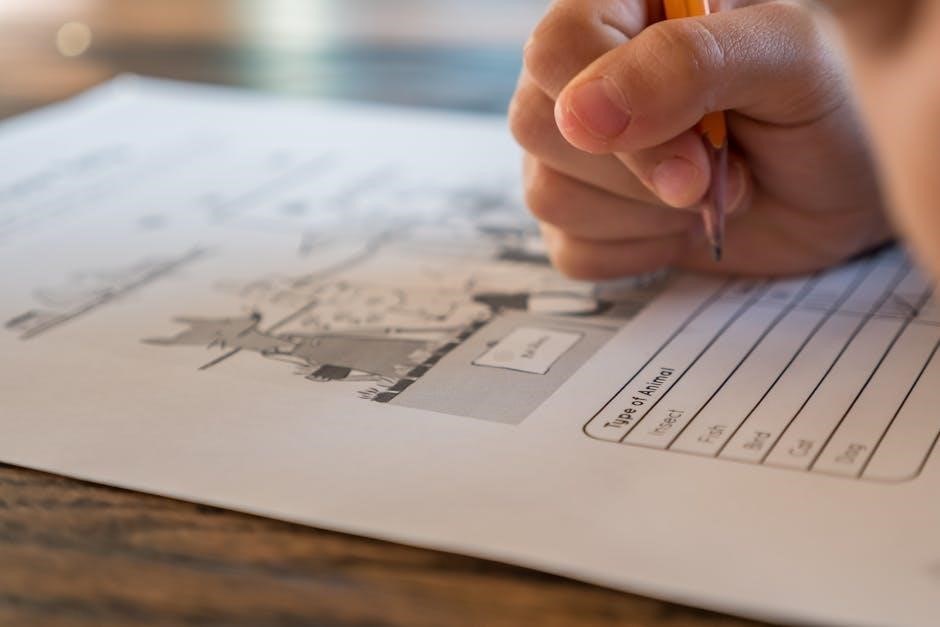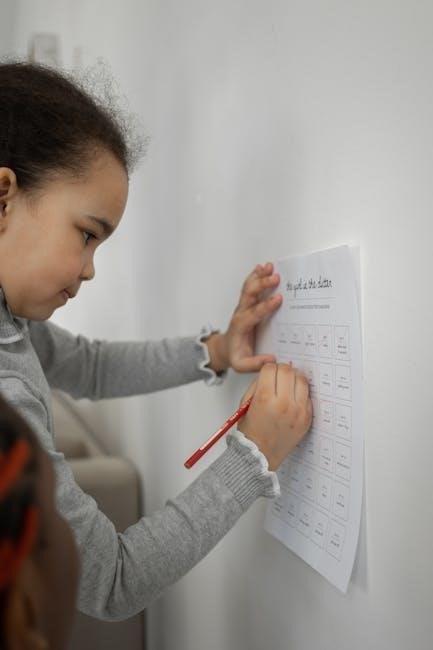Probability worksheets with answers provide structured exercises for understanding probability concepts. They include various problems, from basic to advanced, with solutions for self-assessment and learning.
1.1 Definition and Purpose of Probability Worksheets
Probability worksheets are educational tools designed to help students understand and apply probability concepts. They typically consist of structured exercises and problems that cover various aspects of probability, such as calculating probabilities, understanding sample spaces, and analyzing events. The primary purpose of these worksheets is to provide hands-on practice, enabling learners to grasp theoretical concepts through practical application. Many worksheets include answers, allowing students to verify their solutions and identify areas for improvement. This resource is particularly useful for self-study, homework, or classroom activities, catering to different learning levels and styles.
1.2 Importance of Using Worksheets with Answers
Worksheets with answers are essential for assessing and reinforcing probability concepts. They provide students with a clear understanding of how to approach problems and verify their solutions. The inclusion of answers enables self-assessment, allowing learners to identify mistakes and improve their problem-solving skills. These resources also build confidence by offering immediate feedback and step-by-step solutions. Additionally, worksheets with answers cater to diverse learning styles, making them a valuable tool for independent practice or classroom instruction. They ensure that students grasp key concepts thoroughly before progressing to more complex topics.

1.3 Target Audience for Probability Worksheets
Probability worksheets are primarily designed for students in middle and high school, as well as undergraduate learners, seeking to master probability concepts. They are ideal for classroom use or independent study, catering to various learning levels. These resources also benefit educators who need structured materials for teaching probability. Additionally, worksheets with answers provide a valuable tool for individuals preparing for standardized tests or exams requiring probability knowledge. They ensure that learners at all stages can engage with relevant, challenging problems tailored to their skill development and understanding needs.

Types of Probability Worksheets
Probability worksheets are categorized into theoretical, experimental, and conditional types, each focusing on different aspects of probability calculation and problem-solving for comprehensive learning and practice.
2.1 Theoretical Probability Worksheets
Theoretical probability worksheets focus on calculating probabilities based on known outcomes and defined sample spaces. They involve determining the likelihood of events without experimental data, using formulas like P(event) = number of favorable outcomes / total possible outcomes. These worksheets often include problems such as finding the probability of drawing a specific card from a deck or rolling a certain number on a die. By practicing these problems, students develop a strong foundation in understanding probability principles and applying them to various scenarios. They also learn to identify and list possible outcomes, ensuring accurate calculations and a clear understanding of probabilistic concepts. These exercises are essential for building logical reasoning and mathematical skills in probability.
2.2 Experimental Probability Worksheets
Experimental probability worksheets involve determining the likelihood of events through repeated trials or simulations. These exercises require students to conduct or analyze experiments, such as flipping coins, rolling dice, or drawing cards, to calculate probabilities based on observed outcomes. By comparing experimental results with theoretical probabilities, students gain insights into the law of large numbers and the concept of long-term frequency. These worksheets often include questions about the number of trials, observed frequencies, and comparing experimental probabilities to theoretical ones. They help develop practical skills in data collection, analysis, and understanding the relationship between experimentation and probability. This approach makes learning interactive and engaging, fostering a deeper understanding of probabilistic concepts through hands-on experience.
2.3 Conditional Probability Worksheets
Conditional probability worksheets focus on calculating the likelihood of an event occurring given that another event has already happened. These exercises introduce students to concepts like P(A|B), where event A depends on event B. Problems often involve scenarios such as drawing cards without replacement or medical testing probabilities. Worksheets include questions requiring the use of formulas like P(A ∩ B) / P(B) and Venn diagrams to visualize dependencies. They help students understand independence, dependence, and mutually exclusive events. Conditional probability is essential for advanced topics like statistics and decision-making, making these worksheets crucial for building a strong foundation in probability theory.

Common Probability Problems in Worksheets
Worksheets often include basic probability questions, multiple-event scenarios, and real-world applications. These problems help students understand likelihoods, combinations, and practical uses of probability in everyday situations.
3.1 Basic Probability Questions
Basic probability questions form the foundation of understanding likelihoods. Examples include determining the probability of drawing a specific card from a deck, rolling a particular number on a die, or picking a certain colored ball from a bag. These problems often involve calculating simple probabilities by dividing the number of favorable outcomes by the total number of possible outcomes. Worksheets typically start with these fundamental questions to help students grasp the concept of sample spaces and event probabilities. Mastering these basics is essential for tackling more complex probability scenarios in the future.
3.2 Probability Involving Multiple Events
Probability involving multiple events challenges students to calculate likelihoods when two or more events occur together. These problems often require understanding independent and dependent events. For example, determining the probability of flipping two heads in a row or drawing two specific cards from a deck without replacement. Worksheets include scenarios like rolling two dice, where students must consider all possible outcomes and their combinations. These exercises help build skills in calculating joint probabilities and understanding how events interact. They also introduce concepts like mutually exclusive events and the addition rule of probability, essential for more advanced topics later. These problems are designed to strengthen analytical thinking and probabilistic reasoning.
3.3 Real-World Application Problems
Real-world application problems in probability worksheets bridge theory and practical scenarios, making learning engaging and relevant. These problems simulate everyday situations, such as calculating the likelihood of passing a driver’s test multiple times, determining coin toss outcomes, or predicting weather patterns. They also cover financial scenarios, like investment risks or lottery odds, and engineering applications, such as system reliability. These exercises help students connect probability concepts to tangible, real-life decisions, enhancing their ability to analyze uncertainty and make informed choices in various fields. This practical approach fosters deeper understanding and prepares students for real-world challenges.

Advanced Topics in Probability Worksheets
Advanced probability topics include distributions like binomial and normal, Bayes’ theorem, and applications in statistics. These worksheets explore complex concepts with detailed solutions for deeper understanding.
4.1 Probability Distributions (Binomial, Normal)
Probability distributions, such as binomial and normal, are essential for modeling real-world phenomena. Binomial distributions apply to binary outcomes, calculating probabilities of successes in trials. Normal distributions, or bell curves, describe continuous data with mean, variance, and standard deviation. Worksheets cover these concepts with problems on calculating probabilities, identifying parameters, and interpreting results. These exercises are crucial for understanding statistical analysis, hypothesis testing, and data modeling in fields like finance, engineering, and biology. Detailed solutions guide learners in mastering distribution properties and applications, enhancing their analytical skills for complex probability scenarios.
4.2 Bayes’ Theorem and Its Applications
Bayes’ Theorem is a fundamental concept in probability theory, enabling the calculation of conditional probabilities. It updates probabilities based on new data, providing insights into decision-making under uncertainty. Worksheets on Bayes’ Theorem include problems on conditional probability, prior and posterior probabilities, and likelihoods. These exercises cover applications in fields like finance, engineering, and machine learning. Detailed solutions guide learners in applying the theorem to real-world scenarios, such as medical diagnosis or risk assessment. Mastering Bayes’ Theorem enhances analytical and problem-solving skills, crucial for data-driven decision-making and advanced statistical analysis;
4.3 Probability in Statistics and Data Analysis
Probability is integral to statistics and data analysis, forming the foundation for understanding variability and uncertainty. Worksheets cover topics like sampling distributions, hypothesis testing, and confidence intervals. They explore how probability distributions, such as binomial and normal, are applied in regression analysis and predictive modeling. Exercises include calculating probabilities for real-world datasets and interpreting results. These worksheets help learners connect theoretical concepts to practical data analysis, enhancing their ability to make informed decisions. Step-by-step solutions provide clarity, making complex statistical methods accessible for students and professionals alike.

Applications of Probability in Different Fields
Probability concepts are widely applied in finance, engineering, biology, and computer science. Worksheets explore real-world applications, such as risk assessment, genetic analysis, and algorithm design, with practical examples.
5.1 Probability in Finance and Economics
Probability plays a crucial role in finance and economics, enabling professionals to assess risks and make informed decisions. Worksheets often include problems related to stock market trends, investment returns, and portfolio management. For instance, calculating the probability of stock price fluctuations or determining the likelihood of market trends helps in risk assessment. Economists use probability to model economic scenarios, predict policy impacts, and analyze consumer behavior. These exercises are essential for understanding how uncertainty influences financial and economic systems, making probability worksheets a valuable tool for developing analytical skills in these fields.

5.2 Probability in Engineering and Computer Science
Probability is integral to engineering and computer science, aiding in designing efficient algorithms, modeling systems, and analyzing data. Worksheets often feature problems related to algorithm efficiency, network reliability, and machine learning. For example, calculating the probability of error detection in digital communications or determining the likelihood of algorithm success enhances problem-solving skills. Computer scientists use probability to optimize data structures and predict system behaviors. These exercises bridge theoretical concepts with practical applications, equipping students to tackle real-world challenges in technology and system design effectively.
5.3 Probability in Biology and Medicine
Probability plays a crucial role in biology and medicine, aiding researchers and practitioners in understanding variability and uncertainty. It is used to analyze genetic inheritance, disease transmission, and treatment efficacy. Worksheets often include problems like calculating the probability of inheriting a trait or predicting disease spread in a population. Probability also helps in clinical trials to determine the likelihood of drug success. These exercises enhance analytical skills, enabling professionals to make informed decisions in healthcare and research, ultimately improving patient outcomes and public health strategies.

Resources for Probability Worksheets with Answers
Find free PDF worksheets online, explore textbooks with practice sets, or use custom generators to create tailored exercises for probability learning and problem-solving.
6.1 Websites Offering Free PDF Worksheets
Websites like Kuta Software LLC, MathWorks, and educational platforms offer free PDF worksheets on probability. These resources provide a variety of exercises, from basic to advanced problems, covering topics like theoretical and experimental probability. Many worksheets include answers, allowing students to check their work and understand solutions. They cater to different grade levels and learning needs, making them accessible for both students and educators. These online tools are invaluable for practicing probability concepts and reinforcing understanding through practical examples. They often include visual aids and real-world applications to enhance learning.
6.2 Textbooks with Accompanying Worksheets
by Blitzstein and Hwang, provide structured exercises that align with chapter content. Worksheets cover topics like conditional probability, probability distributions, and Bayesian concepts. They cater to various skill levels, offering basic and advanced problems. Many textbooks also include answer keys, enabling students to verify their solutions and improve understanding. These resources are widely used in academic settings and are ideal for self-study or classroom use, ensuring comprehensive learning of probability theory and its applications.
6.3 Online Platforms for Generating Custom Worksheets
Online platforms offer tools to create custom probability worksheets with answers in PDF format. Websites like Kuta Software and MathWorks provide generators that allow users to customize problem types, difficulty levels, and answer keys. These platforms cater to educators and students, enabling tailored practice for specific topics. They support various probability concepts, from basic to advanced, and often include features for adding real-world applications. Many platforms are free or low-cost, making them accessible for widespread use. They are invaluable for personalized learning and quick resource creation, enhancing the study of probability theory and its practical uses.

Tips for Solving Probability Problems
Understand the sample space, apply basic probability rules, and recognize independent vs. dependent events. Avoid common mistakes like assuming independence or missing outcomes to ensure accurate calculations.
7.1 Understanding Sample Space and Events
The sample space is the set of all possible outcomes of an experiment. Events are specific outcomes or combinations of outcomes within this space. To solve probability problems, clearly define the sample space and identify the events. For example, when rolling a die, the sample space is {1,2,3,4,5,6}, and an event could be rolling an even number. Ensure all outcomes are mutually exclusive and collectively exhaustive. Understanding this foundation is crucial for accurate probability calculations and avoids errors in determining favorable outcomes.

7.2 Calculating Probabilities: Basic Rules
Calculating probabilities involves understanding basic rules and formulas. The probability of an event is the number of favorable outcomes divided by the total number of possible outcomes. For example, the probability of rolling a 3 on a die is 1/6. Use the addition rule for mutually exclusive events and the multiplication rule for independent events. Ensure outcomes are equally likely unless stated otherwise. Practice applying these rules to various scenarios, such as coin tosses or drawing cards, to build a strong foundation in probability calculations. This helps in solving problems accurately and avoids common errors.
7.3 Common Mistakes to Avoid
When solving probability problems, common mistakes include miscounting outcomes, assuming independence incorrectly, and misapplying rules. Ensure the sample space is accurate and all outcomes are equally likely. Avoid overcomplicating problems or ignoring given conditions. Double-check calculations and assumptions. Misunderstanding conditional probability and confusing mutually exclusive events are frequent errors. Always verify the total number of possible outcomes and whether events are independent or dependent. Practicing regularly and reviewing solutions help identify and avoid these pitfalls, leading to better problem-solving skills and a stronger grasp of probability concepts.
Probability worksheets with answers are invaluable tools for mastering probability concepts. They provide structured practice, enhance problem-solving skills, and build confidence in mathematical reasoning.
8.1 Summary of Key Concepts
Probability worksheets with answers cover essential concepts like theoretical and experimental probability, conditional probability, and probability distributions. They help students understand sample spaces, events, and basic probability rules. These resources also address real-world applications in fields such as finance, engineering, and biology. By practicing with these worksheets, learners develop problem-solving skills and gain confidence in applying probability principles to various scenarios. The inclusion of answers allows for self-assessment and reinforcement of key ideas, making them a valuable tool for both students and educators.
8.2 Encouragement for Further Practice
Consistent practice with probability worksheets is key to mastering probability concepts. By solving diverse problems, students enhance their analytical and problem-solving skills. Worksheets with answers provide immediate feedback, helping learners identify and correct mistakes. Exploring real-world applications of probability fosters a deeper understanding of its relevance. Encourage learners to utilize online platforms and textbooks for additional practice. Regular practice builds confidence and prepares students for advanced topics in mathematics and related fields. Embrace challenges and enjoy the journey of learning probability!